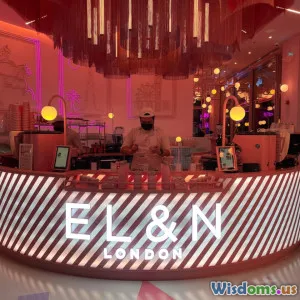
The Psychology Behind Effective Color Palettes in Digital Design
7 min read Discover how color psychology shapes digital design and creates powerful, effective palettes that engage users. (0 Reviews)
The Psychology Behind Effective Color Palettes in Digital Design
Color is more than an aesthetic choice in digital design—it’s a powerful psychological tool that communicates emotions, guides user behavior, and shapes brand perception. In a world saturated with digital interfaces, understanding the psychology behind color palettes can be the difference between engaging users and losing their attention.
This article dives deep into how color affects the human mind, what principles designers use to select impactful palettes, and how real-world examples illustrate these concepts at work.
Why Color Matters in Digital Design
Colors have a profound influence on human cognition and emotion. Studies show that in less than 90 seconds, people form judgments about products primarily based on color alone. When users interact with digital platforms, color affects everything—from usability and ease of navigation to emotional resonance and trustworthiness.
Moreover, the right palette can foster brand identity, create memorable experiences, and influence purchasing decisions. As Dr. Angela Wright, a color psychologist, asserts, “Colors influence people in powerful, sometimes unknown, ways that can either attract or repel.”
The Science of Color Psychology
Emotional and Cultural Responses
Colors evoke widely recognizable emotions: reds signal urgency or passion; blues denote calmness and trust; yellows can invoke happiness or caution. However, these responses are also molded by cultural associations. For example, white symbolizes purity in Western cultures, but can mean mourning in some Eastern traditions.
The Role of Hue, Saturation, and Brightness
- Hue is the type of color (red, blue, green).
- Saturation refers to the intensity of color, with high saturation appearing more vivid.
- Brightness (or value) measures lightness or darkness.
Adjusting these components allows designers to fine-tune mood and readability. For instance, saturated colors draw attention but can overwhelm if overused, while muted tones often feel sophisticated and subtle.
Color Contrast and Accessibility
Effective palettes must consider contrast to ensure all users, including those with visual impairments, can engage with content. The Web Content Accessibility Guidelines (WCAG) recommend minimum contrast ratios (4.5:1) between text and background to enhance readability.
Principles for Creating Effective Color Palettes
1. Define the Emotional Goal
Start with what you want the user to feel. An app promoting meditation may lean towards calming blues and greens, while an emergency alert system might use urgent reds and yellows.
Example: Calm’s meditation app uses soft blues and muted purples enhancing relaxation and focus.
2. Balance Warm and Cool Colors
Warm colors (red, orange, yellow) stimulate and energize. Cool colors (blue, green, violet) soothe and relax. A balanced palette can create harmony or tension, directing user attention strategically.
3. Limit Your Palette for Consistency
A common rule is the 60-30-10 principle: 60% dominant color, 30% secondary, 10% accent. Minimizing color chaos boosts user comprehension and brand cohesion.
Example: Spotify uses a consistent dark green background (dominant), black accents, and light green highlights (accent) for recognizability.
4. Consider Color Blindness and Inclusivity
Roughly 8% of men and 0.5% of women experience some form of color blindness. Tools like Color Oracle simulate color deficiencies, helping designers choose palettes that remain distinguishable for all users.
5. Test in Multiple Contexts
Colors look different across devices, lighting conditions, and screen types. Testing palettes ensures they convey the intended emotions universally.
Real-World Insights: Case Studies
Airbnb’s Evolution to a Frame-Ready Identity
In 2014, Airbnb introduced a vibrant palette using warm reds and soft coral, designed to evoke feelings of warmth and belonging. The choice aligned with Airbnb's goal of humanizing travel and creating welcoming experiences. According to Airbnb’s design lead, the palette was pivotal in establishing emotional connection.
Instagram’s Gradient for Youthful Energy
Instagram’s shift to a magenta-to-yellow gradient was more than a visual update; it expressed creative energy and modernity. The bright hues attract younger demographics attuned to vivid, playful colors, enhancing brand engagement.
Apple’s Minimalist Palette Strategy
Apple exemplifies simplicity with its restrained grays, whites, and blacks, emphasizing sleekness and elegance, which psychologically communicates premium quality and trust.
Harnessing Color Psychology: Tips for Designers
- Research your target audience’s cultural context to avoid misinterpretation.
- Use color to establish visual hierarchy guiding users through content seamlessly.
- Pair empirical science with creativity—data-driven choices still leave room for emotional intuition.
- Leverage color symbolism in branding to align palette with company values and messaging.
- Regularly update palettes in response to trends without sacrificing core brand identity.
Conclusion: Color Palettes as a Psychological Language
Colors in digital design do far more than please the eye; they speak directly to the subconscious. When wielded thoughtfully, color palettes forge stronger connections, emphasize usability, and enhance brand narratives. The unique interplay of science, culture, and creativity behind color choices empowers designers to create meaningful experiences that resonate deeply with users.
In essence, mastering the psychology of color isn’t optional—it's fundamental for impactful digital design. By embracing this knowledge, designers unlock a richer, more engaging visual language that speaks directly to the minds and hearts of their audiences.
Inspired to rethink your next digital project’s colors? Dive into the data, test your palettes, and watch your design’s effectiveness skyrocket.
Rate the Post
User Reviews
Popular Posts




















